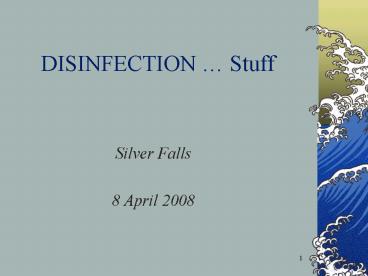DISINFECTION Stuff PowerPoint PPT Presentation
1 / 21
Title: DISINFECTION Stuff
1
DISINFECTION Stuff
- Silver Falls
- 8 April 2008
2
Some Presentation Topics(not necessarily in
order or complete)
- Residual Maint. vs. Disinfection CT
- O3-
- Chlorination calculations Questions?
- (Tracer Study Discussion, if desired)
3
Purpose of Disinfection
- Inactivation of Pathogens
- Bacteria Coliforms, Campylobacter
- Viruses Norwalk, Hepatitis A/B
- Parasitic protozoa Giardia, Cryptosporidium
- Regulatory Requirements
- Residual Maintenance vs. Disinfection
- Why does your system use disinfectant?
4
Waterborne Disease Outbreak Causes
From August 2006 Access AWWA
5
Surface Water Treatment3-log (99.9) Giardia
Reduction
- Log Removal
- 2-log (99)
- 2.5-log (99.7)
- Log Inactivation
- 1-log (90)
- 0.5-log (68.4)
6
Slight, but Significant, Distinctions in
Definitions
- Chlorination General term Add chlorine to
system for any reason. (e.g. Fe Mn) - Residual Maintenance Assure detectable amount
of disinfectant (i.e. chlorine) is in your entire
distribution at all times. - Disinfection Add disinfectant and provide
enough contact time to inactivate pathogens.
7
Disinfection Contact Time v. Residual Maintenance
- Whats the Difference??
- Generally speaking, we require
- Disinfection with Contact Time for contaminated
Sources. - Residual Maintenance for Distribution.
8
Chlorine Residual
- Measure record free chlorine residual daily
- Must be detectable everywhere at all times.
- High levels of iron, manganese, or turbidity will
increase chlorine demand. - Use DPD-type test kit (colorimeter/digital)
9
Why Is Residual Maintenance NOT Disinfection?
Cl
Cl
0.2 ppm Cl residual throughout distribution system
Cl
Cl
Cl
10
Why Isnt Residual Maintenance Disinfection?
Disinfection requires Contact Time
Contamination Point
11
Disinfection CT Values
- Definition
- CT values are a measurement of the effectiveness
of chlorine disinfection against bacteria,
viruses, and protozoa. - Concentration Time CT
- E.g. 1 ppm 6 min 6
12
Groundwater CTs
- Some Groundwater WSs need CTs
- Usually initiated by sourcewater TCs.
- Groundwater Rule may increase incidence.
- CT of 6 requires 30 minutes contact time
- Do you need a Tracer Study???
- What is the pipe tank configuration?
- Alternative estimate 10 of tank volume.
13
Common Disinfectants(In order of prevalence)
- CHLORINE
- Ultraviolet Light (UV)
- Ozone (O3)
- Mixed Oxidants (MIOX)
- Chloramines (Cl2 plus ammonia)
14
Ozone (O3)
- Disinfection and taste/odor control
- Produced by electricity and air or pure O2
- Inactivates Cryptosporidium
- Must be generated on-site
- Leaves minimal disinfectant residual
- Costs 4 times more than conventional
disinfection, yet cheapest LT2 option
15
Onsite O3 Generation
Liquid O2
16
O3 Monitor and Towers
17
Ozone Towers
O2
Plasma
Cooling Water
18
O3 Monitor using UV
19
O3 Monitoring
20
O3 O2 Ambient Safety Monitors
21
Close up of O3 Monitor
22
Demo SS Injection w/ Nozzles
23
Questions?
24
TRACER STUDIES
- What are they and why?
- Who needs to do them?
- How are they done?
25
What are Tracer Studies?
- Tracer studies are tests that are done to
determine the actual disinfection contact time
available.
26
Who Needs To Study Tracers?
- All surface water systems.
- Perhaps some groundwater systems.
- If no tracer study available, contact time is
estimated by DWP staff.
27
Basic Procedure
- Record background level of tracer (usually
chlorine). - Inject more.
- Record time at which 10 increase over background
level is reached. (T10)
28
Conducting Test
- Set maximum flow rate.
- Measure initial chlorine residual.
- Establish monitoring location at first user.
- Add more chlorine.
- Record T10.
29
Graph Results
- Graph shows actual (or effective) disinfection
contact time available. - The hydraulics specifically the detention time
determined in tracer study is used for CT
calculations.
30
Perform Test at Your Peak Hourly Flowrate
31
Perform Test at Your Peak Hourly Flowrate
32
How to Improve Contact Time
- Slow the flow. I.e. produce less water.
- Move point of chlorine application.
- Add additional piping (plug flow).
33
Improving Contact Time (continued)
- Increase contact time in reservoirs
- Walls
- Curtains
- Flow diverters
- Separate inlet /outlet
34
Disinfection CT Values
- Definition
- CT values are a measurement of the effectiveness
of chlorine disinfection against bacteria,
viruses, and protozoa. - Concentration Time CT
- E.g. 1 ppm 6 min 6
35
CT Calculation
- CT Cl2 residual multiplied by contact
time - CT mg/L X minutes
- a number (no units expressed)
- Example 0.2 mg/L times 30 minutes
- CT 6
36
The Magic Number 6for Groundwater
- CT required 6
- 30 minutes 0.2 ppm Cl
- or
- 6 minutes 1 ppm Cl
- Assumptions Water Temperature 10oC (50oF)
37
Required CT ValuesGW vs. SW
- Groundwater
- Minimum CT 6
- Adequate for 4-log virus inactivation
- Surface Water
- Required CT varies with pH, temp, and
log-inactivation requirement - Based on Giardia inactivation 67 or 90.
38
Disinfection Contact Time(not to be confused
with CT Calculation)
- Determined by Tracer Study or interim estimate
- Time effective volume of contact chamber/flow
- Time minutes gal / gal/min
- Pipe flow is ideal
- I.e., 100 credit for pipe volume
- Storage tanks likely have short-circuiting
39
How Do You Really Measure Contact Time? T
Vgal/Qgal/min
- Determine peak hourly demand flowrate
- Does system have an effluent flowmeter?
- Look at the configuration of system.
- Make estimate based on tank configuration
length of pipe - Assume 10 of tank volume if unknown.
- Calculate contact time using effective tank
volume and effluent flowrate.
40
Chlorination Concerns
- Disinfection by-products (DBPs)
- THMs and HAA5s
- DBP production encouraged by
- High chlorine levels
- Long contact time
- Warm weather
- High source water TOC

